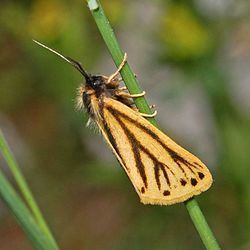Family Arctiidae Scientific name Setina aurita Rank Species | ||
 | ||
Similar Setina, Setina irrorella, Eilema caniola, Manulea complana, Katha depressa | ||
Setina aurita is a moth of the Arctiidae family.
Contents
Subspecies
Distribution and habitat
This species is only found in Central Europe (Austria, France, Germany, Italy, Romania and Switzerland), in part of the Alps between 1,000 and 3,000 meters above sea level. These moths inhabit stony alpine grasslands, rocky slope and sunny meadows.
Description
The wingspan of Setina aurita can reach 25–32 mm. These small moths have whitish-yellow to orange-yellow forewings with longitudinal dark brown stripes reaching the wings margin, where there are black dots. In some specimen only black dots are present on the entire wings. The wing drawing is strongly dependent on the altitude. Usually the moths living at more than 2,000 meters show stripes, while at lower elevation they are more dotted. Caterpillars can reach a length of about 22 millimetres (0.87 in). They are exceptionally long haired, yellow, with five longitudinal grayish-black stripes and grayish-black warts. The head is black.
This species is quite similar to the dew moth (Setina irrorella) and Setina roscida.
Biology
Adults of these day-flying moths can be found from April to October depending on the elevation. The females lay their eggs on stones and rocks. The caterpillars live and pupate usually under rocks. The larvae feed on yellow lichens (Xanthoria parietina) and other lichen species growing on the rocks. This species overwinters, often two or three times, as caterpillars, that are active on mild winter days.
Setina aurita, like other species belonging to the genus Setina, is konwn to emit ultrasounds (a crackling noise) during the flight, with the function of coutship signals.
